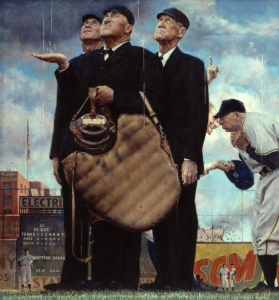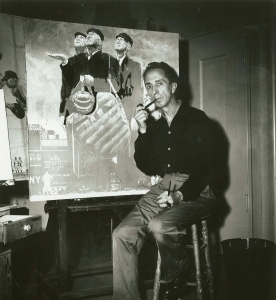
Norman Rockwell (1894-1978)|Tough Call, 1948|Cover illustration for The Saturday Evening Post (April 23, 1949)|Oil on canvas|Collection of the National Baseball Hall of Fame and Museum|© 1949 SEPS: Licensed by Curtis Publishing, Indianapolis, IN
During the 1948 baseball season, Norman Rockwell visited Ebbets Field, home to New York’s Brooklyn Dodgers. He brought along a hired photographer to capture reference images of the ballpark, baseball players, and umpires, for his 1949 Saturday Evening Post cover illustration, Tough Call. Rockwell carried the reference photographs with him to California, where he and his family spent the winter, and he completed the painting.
After the illustration was published, a disgruntled Rockwell wrote to Post art editor Ken Stuart, noting that the original painting of Tough Call “had the piece of sky added when I still feel it was better as I conceived and painted it.”* Photographs of Rockwell at work on the piece show that all the clouds running along the top length of the composition had previously been dark gray. The published version of the painting comprised of a blue sky with lightened gray and white clouds in the top right corner. In addition, the visiting Pirates’ gray uniforms were darkened. Who repainted Rockwell’s canvas?
In the late 1940s, the Post employed a Philadelphia artist, William H. Rapp, to adjust details of other artists’ illustrations including size, signature placement, changing real advertising signs to imagined ones, eliminating brand names, and other minutiae required of the editors.** In addition to changing the sky and uniforms in Tough Call, Rapp modified three other Rockwell covers in 1948 and 1949, done under the direction of Stuart. After the fourth altered cover was published, a displeased Rockwell addressed the situation in a letter to his art editor:
This repainting of my work without my knowledge or consent has never happened to me before with the Post or any other magazine. This is very serious to me. As you know, I am willing to make changes or have a picture rejected, but I do feel that the re-painting of a man’s work to this point is completely unethical . . . I cannot go on painting with any strength or conviction with the threat of such changes to my work constantly hanging over my head.***
An indication of his importance to the magazine, Rockwell’s protests did result in a change of protocol. In addition to Stuart’s assessment, two other editors—editor-in-chief Ben Hibbs, and managing editor Robert Fuoss—would together review Rockwell’s work on arrival, and afterward consult with the artist about possible changes.
Despite its revisions, Tough Call was received especially well by the public. The familiar illustration featured three umpires—Larry Goetz, Beans Reardon, and Lou Jorda—assessing the weather during a Dodgers versus Pirates game. The scoreboard shows the score to be 1–0 Pittsburgh, bottom of the sixth—so if the game is called because of rain, Pittsburgh will officially win. Confused viewers have then wondered why the Pittsburgh manager seems so upset. In order to make Rockwell’s intended scenario clear to readers, the Post wrote, “In the picture, Clyde Sukeforth, a Brooklyn coach, could well be saying, ‘You may be all wet, but it ain’t raining a drop!’ The huddled Pittsburgher—Bill Meyer, Pirate manager—is doubtless retorting, ‘For the love of Abner Doubleday, how can we play ball in this cloudburst?'” ****
Norman Rockwell working on Tough Call, Los Angeles, 1948
Photographer unidentified
Collection of the Norman Rockwell Museum
Norman Rockwell Licensing Company, Niles, IL
* Norman Rockwell to Ken Stuart, August 11, 1949. Norman Rockwell Papers. Norman Rockwell Museum, Stockbridge, Massachusetts.
** “Keeping Posted: Trouble? Phone Bill Rapp,” July 16, 1949, The Saturday Evening Post, 124.
*** Norman Rockwell to Ken Stuart, August 1949. Norman Rockwell Papers. Norman Rockwell Museum, Stockbridge, Massachusetts.
****”This Week’s Cover,” April 23, 1949, The Saturday Evening Post, 3.
August 13, 2009
By Corry Kazenberg, Curator of Archival Collections
Norman Rockwell Museum






